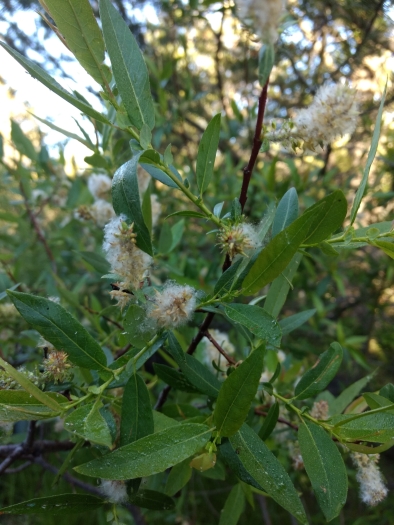Mackenzie’s Willow
(Salix prolixa)
Mackenzie’s Willow (Salix prolixa)
/
/

© Michele Jones
CC BY 4.0
Image By:
© Michele Jones
Recorded By:
Copyright:
CC BY 4.0
Copyright Notice:
Photo by: © Michele Jones | License Type: CC BY 4.0 | License URL: http://creativecommons.org/licenses/by/4.0/ | Uploader: beetle_mch | Publisher: iNaturalist |

























Estimated Native Range
Summary
Salix prolixa, commonly known as MacKenzie’s Willow, is a deciduous shrub native to riparian zones, wetlands, and moist subalpine areas in western North America, ranging from Alaska and northwestern Canada to the high mountains of California and Utah. It typically grows to a height of 3 to 16 feet (0.9 to 4.9 meters) and is characterized by its flexible, slender branches and lance-shaped or pointed oval leaves that can reach up to 6 inches in length, with a glossy green upper surface and a waxy texture underneath. The plant produces yellow or green catkins that bloom in early spring, providing an early source of pollen and nectar for insects.
MacKenzie’s Willow is valued for its ability to stabilize streambanks and for its wildlife habitat benefits, supporting a variety of birds and mammals. It is used in restoration projects, particularly in riparian buffer zones, to prevent erosion and improve water quality. This willow prefers full sun to partial shade and requires consistently moist soil conditions, making it an ideal choice for wet areas in the landscape. While it is not typically grown for ornamental purposes, its natural form and early flowering catkins can add interest to naturalized plantings. Gardeners should be aware that willows can have aggressive roots and may not be suitable for small spaces or near septic systems.CC BY-SA 4.0
MacKenzie’s Willow is valued for its ability to stabilize streambanks and for its wildlife habitat benefits, supporting a variety of birds and mammals. It is used in restoration projects, particularly in riparian buffer zones, to prevent erosion and improve water quality. This willow prefers full sun to partial shade and requires consistently moist soil conditions, making it an ideal choice for wet areas in the landscape. While it is not typically grown for ornamental purposes, its natural form and early flowering catkins can add interest to naturalized plantings. Gardeners should be aware that willows can have aggressive roots and may not be suitable for small spaces or near septic systems.CC BY-SA 4.0
Plant Description
- Plant Type: Shrub, Tree
- Height: 15-30 feet
- Width: 12-30 feet
- Growth Rate: Moderate
- Flower Color: N/A
- Flowering Season: Spring, Summer
- Leaf Retention: Deciduous
Growth Requirements
- Sun: Full Sun, Part Shade
- Water: Medium
- Drainage: Fast, Medium
Common Uses
Bank Stabilization, Bird Garden, Erosion Control, Low Maintenance, Water Garden
Natural Habitat
Riparian zones, wetlands, and moist subalpine areas
Other Names
Common Names: Mackenzie Willow, Prairie Willow
Scientific Names: , Salix prolixa, ? mackenziana, Salix cordata subsp. mackenziana, Salix cordata subsp. mackenzieana, Salix cordata var. mackenzieana, Salix eriocephala subsp. mackenzieana, Salix eriocephala var. mackenzieana, Salix mackenziana, Salix mackenziana
GBIF Accepted Name: